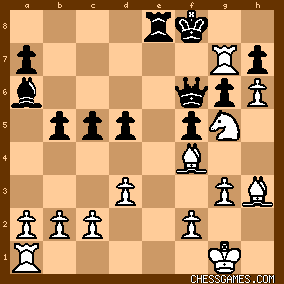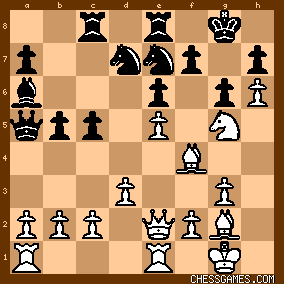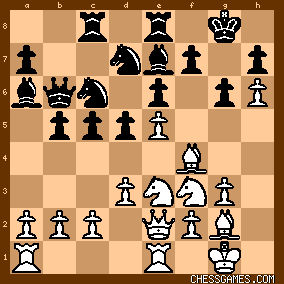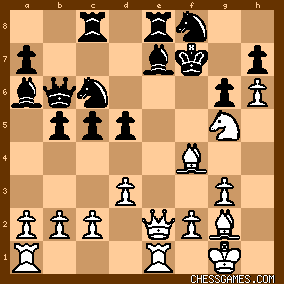|
< Earlier Kibitzing · PAGE 1 OF 2 ·
Later Kibitzing> |
Sep-15-13
 | | FSR: I don't think I would spend much time on this. Just play 17.Nxd5! exd5 18.e6 and leave it to Black to figure out how on earth he's going to try to defend himself from all the pieces coming at his king. |
|
| Sep-15-13 | | PhilFeeley: f7 is weak, the black pieces are mostly on the queen side. Time to strike. Break in with 1. Nxd5, then 2. e6 and watch the juggernaut roll! |
|
| Sep-15-13 | | lost in space: I saw the 17. Nxd5! exd5 18. e6 idea, but in oppisite to the other posters I was not sure if this really wins. So here a few lines to show the ideas:
A: 18...fxe6 19. Qxe6+ Kf8 19. Bd6 Bxd6 20. Qxd6+ Ne7 21. Qxd7 Rcd8 22. Qg4 and win B: 18...Ndb8 19. exf7+ Kxf7 20. Qxe6+ Kf8 21. Bd6 Qb7 22. Qf6+ Kg8 23. Qg7# C: 18...Ncb8 19. exd7 Nxd7 20. Bh3 f5 21. Qxe7! Rxe7 22. Rxe7 and I see no defense, e.g. 22...Qf6 23. Rxd7 Re8 24. Rg7+Kf8 25. Ng5 and Black has to play Qxg7 with huge white advantage 
click for larger viewOf course not complete. |
|
| Sep-15-13 | | Patriot: 17.Nxd5 exd5 18.e6 Nf6 19.exf7+ Kxf7 20.Qe6+ Kf8 21.Ng5  Actually 21...Nd8 seems to defend here. Perhaps 20.Ng5+ first--that seems much stronger here. Actually 21...Nd8 seems to defend here. Perhaps 20.Ng5+ first--that seems much stronger here.17.Nxd5 Nd4 18.Nxe7+ Rxe7 19.Nxd4 cxd4 looks interesting. I'm not sure who has the better deal here. There's a lot more to this than I'm willing to work out tonight. |
|
| Sep-15-13 | | patzer2: Realizing it's a Sunday puzzle, I found 17. Nxd5!! exd5 18. e6 Nf6 19. exf7 Kxf7 20. Qe6+ Kf8 easy enough. However, I didn't see five moves ahead to realize 21. Bd6! is the decisive follow-up. In the final position, 23...Kg8 24. Bxd5+ Nf7 25. Bxf7+ Kf1 26. Nxh7# follows. From this final mate, it's not too difficult to work the combination backwards and clearly visualize the eleven-move-mate in this line after 17. Nxd5!! |
|
Sep-15-13
 | | offramp: How many Sunday puzzles have had all 32 men on the board? |
|
| Sep-15-13 | | M.Hassan: "Insane"
White to play 17.?
Equal
17.Nxd5 exd5
18.e6 fxe6
19.Qxe6+ Kh8
20.Qxd7
And in this chaos, White has gained a pawn.
Continuation in case ...fxe6 is not taken, is very lengthy and I have not worked it out. |
|
Sep-15-13
 | | scormus: <FSR> I think you've judged it dead right. 17 Nxd5 looked the move to me, and looked as if it "must" win after ... exd5 18 e6 even if it was not clear how. In fact, you cannot just hammer away at the BK position. The trick is to see 21 Bd6! when making the original sac. I didnt even see it when I got that far, instead thinking 21 Ng5, but then B can limit the damage with 21 ... Nd8 22 Qe5. Running it on the engine proves quite illuminating. After 17 Nxd5 it recommends declining the N-sac (... Qa5 18 Nxe7 Nxe7 19 Nd2 +1.57) And after 18 e6 it gives the unlikely looking ... Ncb8 (19 exd7 Nxd7 20 Bh3 Nf8 21 Bxc8 +1/71). Despite the pin on the Be7 B seems to be able to fight on at least for a while. Very instructive puzzle! |
|
| Sep-15-13 | | hoodrobin: Insane! |
|
| Sep-15-13 | | Madman99X: I have to agree with your engine, <scormus> After 17... Qa5 18. Nxe7 Nxe7 19. Ng5 (Houdini 1.60 at 18 ply)
click for larger view White certainly has a better position, but there is no obviously decisive win. |
|
| Sep-15-13 | | diagonalley: 'very difficult' certainly... but not 'insane' as some of the moves almost play themselves - nonetheless it was a brilliant attack |
|
| Sep-15-13 | | david ne: everyone is accepting that black accepts the N sac on move 17, what if [as patriot neatly pointed out] he didn`t? I think thats where Pietrsiak made the mistake |
|
| Sep-15-13 | | newzild: Probably the easiest Sunday ever for me, as I play the KIA with White, and the Nxd5 sac is a standard idea after playing Ne3. |
|
Sep-15-13
 | | FSR: <Madman99X: I have to agree with your engine, <scormus> After 17... Qa5 18. Nxe7 Nxe7 19. Ng5 (Houdini 1.60 at 18 ply) White certainly has a better position, but there is no obviously decisive win.> Very often, as here, the opponent does not defend in the "engine-approved" way. Had he done so, the game probably would not have made POTD, since White would have a long way to go to exploit his extra pawn. Tenacious defense is often very frustrating for the attacker who had hoped for a quick win. Two of my wins in the database (I didn't submit either of them) are games where my opponent had been completely rolling me. F Rhine vs G S DeFotis, 1988 F Rhine vs S Nagle, 1997 |
|
Sep-15-13
 | | FSR: As <newzild> said, the Nxd5 sac is old hat in the KIA. I'm surprised that the only similar example I could find in the database is R Panjwani vs A Tuxanidy Torres, 2009. |
|
| Sep-15-13 | | King Sacrificer: Continuation after <18...Nf8>, anyone please? |
|
| Sep-15-13 | | Once: This is a game of paradoxes. In one sense, it is an easy Sunday. The first few moves mostly play themselves. As <FSR> rightly says, many of us would cheerfully play into this line without calculating through to the end. It's a standard tactic in the KIA. In another sense, this is hard. Black has several defences other than the game line which put up sterner resistance. I spent a long time looking for a convincing way to attack if black simply ignores the initial knight move. Sorting out all the variations would be a mammoth task, and respec' to anyone who does it today. The other paradox here is that white attacks where black appears to be stronger. Take a look at the starting position: 
click for larger viewThe phalanx of black pawns from f7 to d5 seems to be a strength. Okay, so f7 might be weak, but the pawns diagonally in front of it seem to be made of concrete. But here is the funny thing, the diagonal from d5 to f7 is weak and part of the reason for that is because it is stuffed full of pawns. The pawns are occupying spaces that pieces would otherwise be sitting on or controlling. And because black had such a strong pawn structure he did not want to overprotect it with distant pieces. We are taught to give our pieces freedom of movement, and that means not having them drearily defending pawns unless we have to. Take the pawns away and we often find that the space they were sitting on is not well defended by pieces. So there you have two paradoxes. A position which is either very easy or very hard, and a diagonal which is simultaneously very strong or very weak. It is a delightfully thought-provoking and ambiguous game that we play. |
|
Sep-15-13
 | | FSR: <King Sacrificer: Continuation after <18...Nf8>, anyone please?> <19.exf7+ Kxf7> [19...Kh8 20.Be5+! Nxe5 21.Qxe5+ Bf6 (21...Qf6 22.Qxf6+ Bxf6 23.fxe8(Q) Rxe8 24.Rxe8) 22.fxe8(Q) Rxe8 (22...Bxe5? 23.Qxe5+ and mate on g7) 23.Qxe8 leaves W with two rooks for a bishop] <20.Ng5+> 
click for larger view<20...Bxg5> [20...Kg8 21.Bxd5+ Kh8 22.Nf7+ Kg8 23.Nd6+ Kh8 24.Qe5+! (flashier than 24.Be5+) Nxe5 25.Bxe5+ Bf6 26.Bxf6#; 20...Kf6 21.Qe6+! Nxe6 22.Rxe6+ Kf5 23.Bh3#] <21.Bxd5+> and now after either 21...Kf6 22.Bxg5+ Kxg5 23.Qd2+ or 21...Ne6 22.Bxe6+ the sky is falling. |
|
| Sep-15-13 | | Sihlous: This is definitely the easiest Sunday I've ever seen...You only need to really see a few lines to see the sac is completely sound and therefore winning. |
|
| Sep-15-13 | | morfishine: Sunday is surely the funnest day for the POTD. Here, with nothing traded, I'm looking at the Black pawn chain f7/e6/d5 as points of attack. This suggest two candidates: 17.Ng5 and the immediate 17.Nxd5
I soon decided that 17.Ng5 was "too long" and seemed to lack an "insane" quality, So, lets look at the second candidate: 17.Nxd5 (2) <17.Nxd5 exd5 18.e6 Nf6 19.exf7+ Kxf7 20.Qe6+ Kf8> So far, so good. Unffortunately, here I underestimated the strength of 21.Bd6 thinking after 21...Bxd6 22.Qxd6+??? Ne7 and Black is safe; Of course, its clear now Black can't play 21...Bxd6??? due to 22.Qxf6+ Kg8 23.Qg7# My line fizzled out after: <21.Ng5 Nd8> *****
PM: I'll subordinate any Post Mortem analysis to the comments and advice of <FSR>: Nice posts! <Once> Interesting your illuminating comments on the pawn chain f7/e6/d5 ***** |
|
| Sep-15-13 | | King Sacrificer: Thanks <FSR>. It seems there's no way to prevent white queen from landing on e6. |
|
| Sep-15-13 | | agb2002: The complete material is on the board.
White can open the position for the attack with 17.Nxd5: A) 17... exd5 18.e6
A.1) 18... fxe6 19.Qxe6+ and 20.Qxd7 wins a pawn and the queen can escape to h3. A.2) 18... Nf6 19.exf7+ Kxf7 20.Bd6 (20.Ng5+ Kf8 (20... Kg8 21.Qe6+ Kh8 22.Qf7 Rg8 (22... Bf8 23.Qxf6+ and mate in two) 23.Qxf6+ Bxf6 24.Nf7#) 21.Qe6 Nd8, unclear) A.2.a) 20... Bxd6 21.Qxf6+ Kg8 22.Qg7#.
A.2.b) 20... Ng8 21.Ng5 wins.
A.2.c) 20... Nd8 21.Qxf6+ Nf7 22.Qg7#.
A.3) 18... Nf8 19.exf7+ Kxf7 20.Ng5+ Bxg5 (20... Kg8 21.Bxd5+ Kh8 22.Nf7+ Kg8 23.Nd6+ Kh8 24.Be5+ Nxe5 25.Qxe5+ Bf6 26.Qxf6#) 21.Bxd5+ A.3.a) 21... Ne6 22.Bxe6+ Rxe6 (22... Ke7 23.Bxc8+ wins; 22... Kf8 23.Qf3+ and mate in three) 23.Qxe6+ Kf8 24.Bd6+ Ne7 (24... Be7 25.Qf6+ Ke8 26.Rxe7+ Nxe7 27.Qxe7#) 25.Bxe7+ Bxe7 26.Qxe7+ Kg8 27.Qg7#. A.3.b) 21... Re6 22.Bxe6+ is similar or transposes to A.3.b. A.4) 18... Nb8 19.exf7+ Kxf7 20.Qe6+ Kf8 21.Bd6 with the threats 22.Qf6+ and 22.Ng5 looks winning. A.5) 18... Nde5 19.Nxe5 Nxe5 (19... fxe6 20.Nd7 Qb7 (20... Nd4 21.Qe5) 21.Qxe6+ Kh8 22.Qf7 Bf8 (22... Rg8 23.Rxe7) 23.Rxe8 etc.) 20.Qxe5 with multiple threats (21.Qg7#, 21.B(Q)xd5, 21.exf7+) looks very good for White. B) 17... Nd4 18.Nxd4 exd5 19.e6 with an extra pawn and attack chances. C) 17... Qd8 18.Nxe7+ weakens the dark squares around the black king, with an extra pawn and the bishop pair. |
|
| Sep-15-13 | | bubuli55: I thought that's pretty easy for a Sunday. All forced moves once White's strong center is recognized. 17. Nxd5 exd5 18. e6 Nf6 19. exf7 Kxf7 20. Qe6+ Kf8 21. Bd6 Ng8 22. Ng5 Nxh6 23. Qf6+ Kg8 23. Bxd5+ Nf7 24. Bxf7+ Kf8 25. Ne6# First Sunday :) |
|
| Sep-15-13 | | dakgootje: <Take the pawns away and we often find that the space they were sitting on is not well defended by pieces.> Heh, that's an interesting idea!
I should remember it, although (after years of experience with myself) I probably won't. |
|
Sep-15-13
 | | Penguincw: 17.Ng5 looked intriguing to me. |
|
 |
|
< Earlier Kibitzing · PAGE 1 OF 2 ·
Later Kibitzing> |





